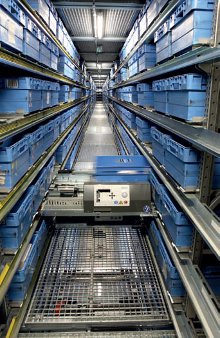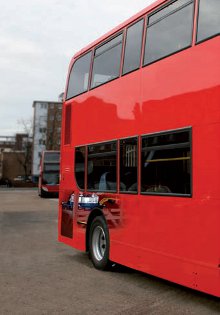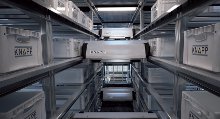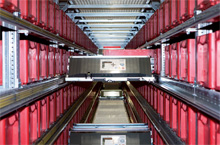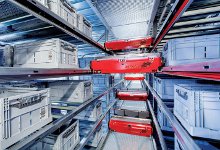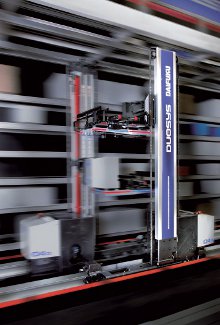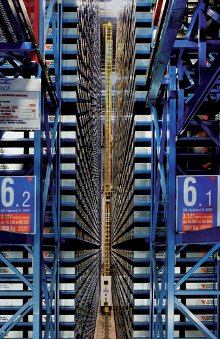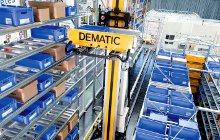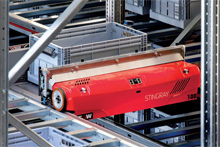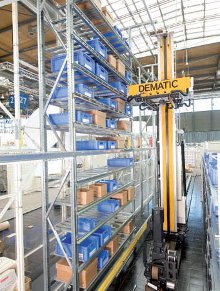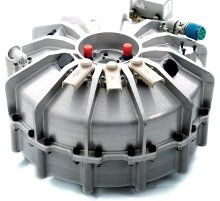The future of AS/RS
2 August 2013Faster and more sustainable systems, tied to more and more robotics are the future for AS/RS, reports Adrian Greeman.
Ever higher speeds and multiple flows of items in storage are among the trends currently being seen in automated storage and retrieval systems for wholesale, retail and production warehousing. Both multiple access shuttle systems and high speed single aisle crane lift systems are developing further than ever.
As they increase in speed and capability new issues are emerging particularly around use of increasingly expensive energy leading to lighter weight devices, power saving systems and the use of "no light" storage space accessed only by automated lifts.
"The major tendency over the last thirty years has been the move away from palletised storage, which requires movement and access of single product types in bulk quantities, to storage and access in much smaller quantities, usually in plastic tope boxes or the cardboard package items arrive in," says Dave Berridge, secretary of the Automated Material Handling Systems Association in the UK.
Tailored delivery quantities for just-intime production areas or just-in-time shelf stocking at modern supermarkets and shops, which no longer waste valuable property space for big in-store warehouses, mean the demand for precisely packaged orders. Each destination's order now comprises a mixed delivery assembled from just the needed quantities ordered at the last minute. Internet ordering from central distribution depots, often sited near postal and courier hubs, for everything from electronics to clothes or groceries adds to the demand.
High speed selective access to thousands, or even tens of thousands of lines, has seen the development of miniload rack storage crane systems, usually with stock keeping units (SKUs) stored one deep either side of an aisle or possibly two deep, the crane juggling the items around as needed.
Within the last decade shuttle systems have been introduced, a separate autonomous shuttle picking up from multiple deep storage points at each rack level, delivering to a crane lifter at the end, which saves space within the storage volume. Such machines can produce higher flows through the warehouse.
Europe has seen the development of these ahead of the States says, Tom Coyne vice-chair of the AS/RS sector at the Materials Handling Institute of America. "It is driven by economic factors, and particularly property restrictions since there is more land space here and there was less pressure to save space.
"Standardisation of box sizes and unit sizes, particularly with the Europallet and Eurotope has been important" he says, adding that it would be good for the States as well, as its an area "where every industry has its own formats."
He says both crane and shuttle systems are being more and more tied with increased automation and robotisation. "Many users do not just want a stand alone warehouse but a complete system of automated storage, picking and packing."
He sees both system types, miniload cranes and shuttles, as complementary in the market depending on user needs; the shuttles are more expensive and require greater infrastructure such as power rails at each level, computer connections and the like, so suit therefore customers with bigger storage and greater ranges of SKUs who can make the bigger investments.
"It is a question of needs" he says "with slower moving storage like spare parts handling perhaps would make more use of the mini-load cranes, though they are not limited to that." Major manufacturers like Dematic or Daifuku are offering both types of system, indicating that they both have their place he adds.
It is a question of "choosing your weapon," says Andrew St Vincent, marketing manager in Japanese supplier Daifuku's European division. Possibly the biggest in the market, it has been offering shuttle systems since the mid-1990s.
But even miniload systems can perform fast. One of its latest products, the Duosys, can produce a maximum storage and retrieval throughput of up to 2,200 cases per hour according to Daifuku.
It features dual cranes for a super-fast performance says St Vincent. The cranes have a tuning control technology that let two stackers functioning in the same aisle, moving past each other without interference to perform storage and retrieval operations.
The system is laid out in two levels so that four stacker cranes operate simultaneously on the same rack.
The technology is continuing to develop says Berridge. "Tolerances in the crane movements as they arrive at a storage position and remove items are an important area of engineering improvement, because that means items can be stored tighter together". The same applies to energy use, according to Berridge, which remains a critical developments at present.
Coyne agrees, saying that days of very cheap oil in the US are over and restricting energy consumption is important. Light and heating free rack storage and conveyors that automatically shut down if no items pass, are typical measures. For aisle cranes and lifts, new lightweight units are increasingly prevalent which both reduces energy consumption and allows faster stopping and starting.
Coyne's "day job" is with the American division of mid-level supplier System Logistics from Italy, making both pallet and mini-load automated systems. "Their solution currently is to re-engineer the crane structure to use 35% less steel, with a lattice rather than the box mast and components most commonly adopted in the past" he says. "They have laser cutters, computerised jigs and welding to achieve the lattice complexity".
Other companies have turned increasingly to aluminium as a solution, more difficult to engineer but much lighter. Major firms such as Germany's Dematic have new systems taking advantage. "With lighter materials you move less weight and use less energy" says Carl Lohmann, global sales director.
Dematic developed a shuttle system some years back he says but its latest product is a miniload crane system, the "Rapid Store ML" which is declares highly dynamic and energy efficient.
The system has a modular concept and is scaleable for overall heights of four to 20m with two single mast machines, the "RapidStore ML 10" and "RapidStore ML 14" designed for 10m and 14m maximums and a the double mast RBG "RapidStore ML 20" for up to 20m.
New design features allow a high-end performance with driving speeds up to 6m/sec and a lifting acceleration of maximum 4m/sec2 says the company.
An increasingly important feature of machines is equipping them with diverse load carrying devices for cartons, containers or trays. Several load supports can be used in different positions (on top of each other or side by side).
"That technology is also important as machines get faster and reach the limits of friction grip and gravity acceleration rates" says Coyne. "It can become necessary to hold a load from above as well for example."
Shuttle installations in Europe meanwhile are becoming mainstream. They include a new £50M order processing centre for 25,000 product lines for an ecommerce operation run by British pharmaceutical and beauty products retailer Boots. An additional 2.500 products are added for the Christmas gift ranges.
At the heart of facility are two of Knapp OSR Shuttle systems, providing automated storage combined with goods-to-person order picking at ergonomic Knapp Pick-it- Easy workstations.
One of the shuttles handles 46000 storage locations for containers up to 15 kg in weight and the other - with 25,700 locations - is for containers up to 25 kg.
The system is ideal for slow- and medium-moving goods says Knapp which comprises the majority of the inventory at Burton. Fast-moving products are picked in a flow rack area at workstations that utilise pick-to-light technology.
Knapp also supplied its KiSoft warehouse management system (WMS) and KiSoft warehouse control software (WCS) and will maintain the handling system.
Major firm TGW has recently launched a completely new shuttle system, the Stingray much enhanced from its first in 1995, the Transrobo. "Back then, each device operated three rack levels. Today, shuttles are smaller, lighter and faster, and far more flexible in handling different types of load carriers" says TGW.
Stringray offers high performance and is flexibly scalable with a modular design says the firm. Operators can vary the number of shuttles used with one on each rack level as well as two tote lifts in each warehouse aisle for maximum throughput. For lower performance requirements, individual shuttles change levels via a shuttle lift Because travel and lift axes are functionally separate the system gives a higher throughput than most stacker cranes and has more accurate scalability of capacity and performance in top-end applications, extremely high availability as well as maximum energy efficiency as moving masses are reduced.'
Meanwhile a bit of Formula One glamour may soon reach warehouses via energy recovery systems developed initially for racing cars.
Most companies are using electronic regeneration systems to avoid wasting energy, Dematic's new product does for example but the fast stop and reacceleration needs of Formula One could be ideal for cranes and shuttles believes Berridge.
In the past, the energy released when stacker cranes came to a halt, or when a load was brought down to ground level, was simply wasted, turned into heat by friction in brakes.
An element of the problem is what to do with the energy. Some systems produce electricity by using generators as brakes, and this is then put back into the grid "which allows you to tell the customer what has been saved," says Coyne. "But it is better to reuse the energy in the same machine if possible," according to Berridge. One answer is batteries but another is to story the energy another way. He is working with the Williams F1 Team, based in southern UK, to adapt a high density flywheel system to cranes. The fast car technology is now being marketed via a spin-off company Williams Advanced Engineering and has been used in buses and Audi cars.
According to a Williams spokesman the system uses electrical power to rapidly spin up a wheel and then return the energy to the motors when needed like an "electromechanical battery" .
"A flywheel rotor spins up to 50,000 rpm and releases energy it as the spinning rotor slows. An electromagnetic coupling between a vacuum-housed, high inertia composite rotor and a central, non-spinning, liquid-cooled stator enables the conversion." Another factor in saving power is the software used to control the storage equipment, from the controllers for the stackers and shuttles themselves to the warehouse control systems says Dematic's Lohmann. Efficiencies can be achieved in setting the order in which items are retrieved and moved to lifting points, particularly if synchronising with other units.
An added complexity is building in redundancy of storage to keep processes going in the event of an equipment breakdown.
Some system use a double storage point redirecting as necessary with the control software. Daifuku's Duosys additionally allows for one of its two stackers to continue accessing the whole rack on its own, albeit at a slower speed.
